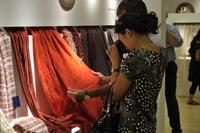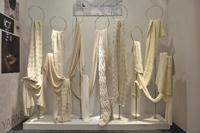 20 July 2009, Florence - Italian and foreign buyers met in Florence from 7 - 9 July when Pitti Filati opened its doors for three days of excellence in international spinning. Organisers say that buyers of particularly high quality were introduced to the new collections, themes, colours, and preliminary inputs for the trends we’ll be seeing in the market eighteen months from now.
20 July 2009, Florence - Italian and foreign buyers met in Florence from 7 - 9 July when Pitti Filati opened its doors for three days of excellence in international spinning. Organisers say that buyers of particularly high quality were introduced to the new collections, themes, colours, and preliminary inputs for the trends we’ll be seeing in the market eighteen months from now.
“During these three Pitti Filati days we perceived a strong desire for concreteness”, says Raffaello Napoleone, CEO of Pitti Immagine, “which helped stave off the pessimism surrounding the economic results that characterized the yarn industry in 2008. Members of the trade are aware that the next few months won’t be easy, that it will take time to get consumption going again and consequently to return to full production, but this edition went very well, much better than expected. The companies tell us they had top-quality visitors and saw all the most important representatives of the big brands and the large fashion groups, who came to Florence eager to see the new collections and place orders, knowing that they’d find just the inputs they need for their creative research.”
Just a few hours before the show concluded, final attendance figures were showing a buyer total of more than 4900 (as compared to the 5500 last summer edition), substantial stability as regards the Italian market, and a slight, though foreseeable, decrease in foreign turnout of around 10%. Organisers said they were seeing good performance by important markets such as France, Switzerland, Portugal, Greece, and Taiwan, and the greatest difficulties concentrated among their visitors from Japan, Korea, and UK. Germany was once again in first place in terms of buyer turnout.
 “We are also very satisfied with the synergy now underway with Pratotrade for the Prima–Moda Tessuto fabrics fair,” concludes Raffaello Napoleone. “This first edition won widespread approbation from buyers and among the companies themselves. This chance to bring together the yarns collections and the fall-winter 2010 fabrics collections is an excellent opportunity for the buyer public, since it permits moving up our timelines even more, reading trends well in advance, and increasing concrete occasions for doing business.”
“We are also very satisfied with the synergy now underway with Pratotrade for the Prima–Moda Tessuto fabrics fair,” concludes Raffaello Napoleone. “This first edition won widespread approbation from buyers and among the companies themselves. This chance to bring together the yarns collections and the fall-winter 2010 fabrics collections is an excellent opportunity for the buyer public, since it permits moving up our timelines even more, reading trends well in advance, and increasing concrete occasions for doing business.”
Giovanna Taiana Tully, knitwear product development team leader at HUGO BOSS
“The mood here is good, overall. In the past few days I have seen yarns collections that are very interesting for our research, and certain product types we will definitely develop over the next few months. The quality of the companies’ work and research, yarn development and intelligent blends is outstanding. This is a sign that the general economic crisis is not penalizing these areas, which are extremely important for our work.” Said Giovanna Taiana Tully, Knitwear Product Development Team Leader at Hugo Boss.
Salvatore Ferragamo’s Patrizia Noferi and Antonio Faggian were very positive about this Pitti Filati and commented: “This is a fine edition of Pitti Filati, and as we see it, even more positive than the last: perhaps because the winter yarns season is stronger than summer and the general mood among the operators is more optimistic. We would like to see even more research in the companies’ collections, but overall we believe that the mills are making massive efforts to always propose interesting product novelties and to present them to clients in their best light.”
Sarah Ogden, Associate Product Manager for women’s sweaters at Aamani Exchange was upbeat about her first Pitti Filati: ““This is my first time at Pitti Filati, and I must say that I’m seeing lots of activity. There are many novelties that I find interesting, knitting stitches that offer inspiration, new proposals for yarn production and treatments, and the colour palettes proposed by the companies. I believe that the top performers on the next fall-winter market will be lighter, finer yarns with greater luminosity and brilliancy and with eye-catching textures.”
 Stefanel’s Knitwear Marketing Manager Emanuela Zanibellato said: “Without a doubt, we feel the mood set by the crisis at the stands, but for us the consequent rationalization of turnout is not such a bad thing, all in all: those of us who came to this edition came to work in concrete terms, to place orders and to do business, and for these reasons alone. I’m seeing great proposals in the collections; I believe that the companies are doing their utmost and that despite everything they are investing in research and innovation. Coming to Pitti Filati is a fundamental step in my research; it’s an important stimulus to setting out on our work for the next season fully armed and ready to go.”
Stefanel’s Knitwear Marketing Manager Emanuela Zanibellato said: “Without a doubt, we feel the mood set by the crisis at the stands, but for us the consequent rationalization of turnout is not such a bad thing, all in all: those of us who came to this edition came to work in concrete terms, to place orders and to do business, and for these reasons alone. I’m seeing great proposals in the collections; I believe that the companies are doing their utmost and that despite everything they are investing in research and innovation. Coming to Pitti Filati is a fundamental step in my research; it’s an important stimulus to setting out on our work for the next season fully armed and ready to go.”
Olga Maltseva, owner of Russia Styling , Moscow said she had been coming to Pitti Filati for three years now to purchase yarns for the compnay’s high-end childrenswear collection, which it markets throughout the Russian territory. “Coming to Pitti Filati is very important to me, both from the point of view of production and as a source of inspiration in terms of design: the Spazio Ricerca is an incredible observatory on next season’s trends – and on knitting stitches research as well. I believe that holding the fair at the same time as Prima–Moda Tessuto offers us yet another opportunity, since it gives us an important preview of fabrics”, Ms Maltseva said.
“At this edition of Pitti Filati I am seeing highly original collections, and I am very pleased to see that the products by the Japanese companies here at the fair have made such great strides in quality terms. I also found Who and I, this edition’s Spazio Ricerca, to be very useful for my work: it has provided me with lots of input in terms of themes, colours, and knitting stitches, which for me represent an important confirmation of many ideas I was already toying with for the upcoming season,” said Chizuko Wakabayashi, Chief Designer at Jaklin Co. Ltd., Toyama-City, Japan
Among the exhibitors, Stefano Borsini, President of Manifattura Igea, spoke about, “an edition that surpassed all expectations, at which the numbers were down a bit but the buyer quality was very high. We saw many qualified American buyers and, great interest on the part of the German buyers, though certainly a few less Japanese. The Italians made a good showing, in greater numbers than had been forecast and all very interested in our collections’ novelties. The new fair scheduling – from Tuesday through Thursday – was also quite effective, since it ensured a more evenly distributed flow over the three fair days.”
Luciano Bandi, Yarns Business Unit Manager for Loro Piana said: “We are very satisfied. For us, this was a highly positive edition of Pitti Filati. The results were good in terms of organization, and it may well have been the most successful edition in recent years as regards both the number of buyers and above all, the quality of the turnout.”





